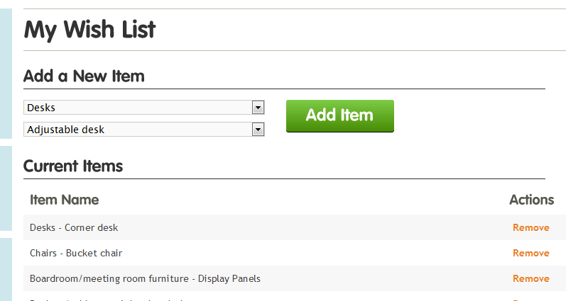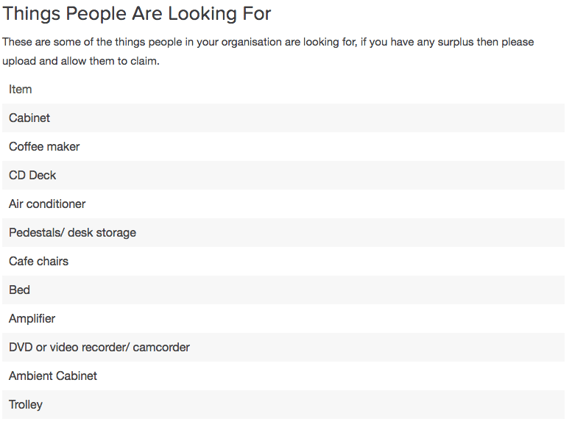But we have no storage we cannot reuse!
Welcome! In this blog post we’re going to look at how you can use a thing called "the wishlist" to run your reuse program without the need for and take the pressure off storage.
What is a wishlist exactly? Remember when you were a child writing letters to Father Christmas? Well, it’s similar to that, it’s a list of things you would like to receive, except, with Warp It, they’re free, and you can get them all year round, not just on Christmas day!
How do wishlists work?
Wishlists work like this: say for example that today you are looking for a Task Chair. You do a search on the Warp It system and in this example, you can’t find one. So, instead of being disappointed, you add ‘Task Chair’ to your wishlist. Now, if anybody in the future lists a Task Chair, and they will, you’ll be the first to get a notification.( If you’re absolutely desperate for a Task Chair, this solution isn’t for you, but if you can plan ahead and manage your procurement around a longer time frame, it’s worth it).

Why is this beneficial ?
Using a wishlist system reduces reliance on storage by directly matching needs and wants peer to peer- directly. It saves double handling.
Picture yourself in the shoes of the disposer, and you’re getting rid of some task chairs. You add them to the system. You’ve found an instant match, hooray!
Instead of taking your old chairs to storage(or worse- landfill!), waiting for a suitor , then moving them to their new place of use, you’re able to take them from A to B. This is a quicker disposal than usual, and has the additional benefits of saving disposal and procurement costs, as well as reducing environmental impact, plus, your colleague is happy with a new chair.
Both parties get a warm and fuzzy feeling inside knowing that they’ve done the right thing.
Zero hassle
The person who received the chair didn’t have to keep logging in every few days to check up on the listings and see if a chair became available. Equally, the person listing the chairs didn’t have to keep logging in and seeing if there was any interest (although they would get an email if there was). The purpose of the Warp It system is to save money, time and the environment.
Better process for internal logistics Under normal circumstances, the internal logistics within an organisation or department, might take the Task Chair and throw it straight in the dumpster or skip. This doesn’t help anyone. Another scenario, and perhaps likelier in more resourceful organisations, is that the Task Chair gets put into storage somewhere, where it would sit and gather dust until someone found use for it, or it could be cleared in bulk with other ‘junk’. Both of these can be avoided with an internal reuse system which matches needs and wants in real time- using a wishlist. This is an obvious and improved waste disposal policy. Storage can be a drag.... Storage is useful if instant matches are not made. However storage is expensive and you can use this as a way to encourage staff to use the wishlist function. Other inefficiencies of storage include:
Avoid storage and match assets in real time If you can match assets in real time using Warp It, you, your colleagues, your managers and the senior management are all going to start being incredibly impressed by the results and the new approach to resource management. The porters or logistics people will be happier with less lifting, the procurement team will be happier that there’s less paperwork and more available budget, and the disposers and recipients will be happy that the transactions are so smooth and efficient.
It makes a lot more sense to find a new home for an asset on the same estate, or in the same network, as it’s quicker and simpler. With the wishlist, when an instant match is found, the item can be exchanged as soon as possible! |
The power of the wishlistTo promote the wishlist in your organisation you can download some campaign materials here |









